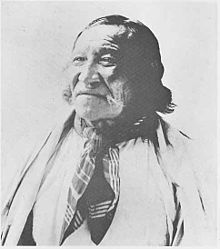Crow Dog
Crow Dog , lak. Kȟaŋǧí Šúŋka , transl . Crow dog (probably * 1834 , † 1911 ), was a member of the Brulé tribe . Crow Dog gained notoriety through the murder of the chief of the Brulé Spotted Tail (lak. Siŋté Glešká ), the subsequent death sentence and the pardon by the US authorities.
Life
Crow Dog was born into a family of distinguished warriors and was a respected warrior himself before moving to the Indian reservation. At the latest there he seems to have become a rival of chief Spotted Tail. He was in Fort Robinson in 1877 when Crazy Horse was killed there. He helped calm his tribesmen and deter them from revenge.
From about 1878 to 1882 he was chief of the Indian police in the Rosebud Agency. In 1880 he succeeded in bringing Spotted Tail to the tribal council, where the latter was supposed to comment on rumors that he was selling tribal land to a railway company and enriching himself personally. In July 1880, Spotted Tail denied all allegations and the council decided, against the vote of Crow Dog, to continue recognizing Spotted Tail as the chief chief of the Brulé-Lakota.
The situation came to a head and on August 5, 1881, Crow Dog shot and killed his rival Spotted Tail. Hollow Horn Bear, who served as a captain in the Indian Police, arrested Crow Dog. Since Spotted Tail's family agreed to accept blood money , the Lakota view the matter as settled.
negotiation
However, the cold-blooded killing of Spotted Tail outraged many Americans living in the Territory, after which Crow Dog was tried and sentenced to death for murder. However, the US Supreme Court overturned the judgment in 1883, as the jurisdiction in the reservations was not for the US authorities. Crow Dog was released. As a result of this decision, a legal regulation was created which, from 1885, made jurisdiction over serious crimes subject to US sovereignty, the ( Indian Appropriations Act or Mayor Crimes Act).
In 1889, Crow Dog signed, along with many others, the contract to divide the large Sioux reservation into several individual areas, which involved considerable land cessions. A little later he was a supporter of the ghost dance movement and protested against the occupation of the reservation by the military. He fled to the Badlands with Two Strike and others in November 1890, but after talks with the army was ready to give up and went back to the agency. His last two decades in the rosebud reservation area were calm.
literature
- Laurence French: Native American justice. Burnham Inc., Chicago 2002, ISBN 0-8304-1575-0 , from page 103
- Raymond Tatalovich, Byron W. Daynes: Moral controversies in American politics. Cases in social regulatory policy. Verlag ME Sharpe, Armonk [u. a.] 1998, ISBN 1-56324-994-4 , pages 87, 88
- Frankie Y. Bailey, Steven M. Chermak: Famous American Crimes and Trials. Volume 2: 1860–1912 , Verlag Praeger, Westport, Conn. [u. a.] 2004, ISBN 0-275-98335-8 , from page 101
Web links
Individual evidence
- ↑ Raymond Tatalovich, Byron W. Daynes: moral controversies in American politics. Cases in social regulatory policy. Verlag ME Sharpe, Armonk [u. a.] 1998, ISBN 1-56324-994-4 , page 87
- ↑ Sidney L. Harring: Crow dog's case. American Indian sovereignty, tribal law, and United States law in the nineteenth century. Cambridge University Press, Cambridge [u. a.] 1994, ISBN 0-521-41563-2 , ISBN 0-521-46716-0 , digitized
This article is based on the article Crow Dog ( Memento of July 1st, 2010 in the Internet Archive ) from the free encyclopedia Indianer-Wiki ( Memento of March 18th, 2010 in the Internet Archive ) and is under Creative Commons by-sa 3.0 . A list of the authors was available in the Indian Wiki ( Memento from July 1, 2007 in the Internet Archive ).
| personal data | |
|---|---|
| SURNAME | Crow Dog |
| ALTERNATIVE NAMES | Kȟaŋǧí Šúŋka (Lakota) |
| BRIEF DESCRIPTION | Member of the Brulé, killers of Spotted Tail |
| DATE OF BIRTH | uncertain: 1834 |
| DATE OF DEATH | 1911 |

